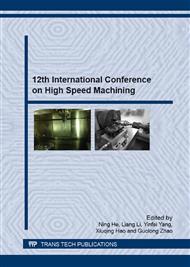p.99
p.106
p.112
p.117
p.126
p.132
p.139
p.147
p.155
Friction Modeling and Experimental Research of Tool-Chip in Turning Titanium Alloy Ti6Al4V
Abstract:
Cutting force, cutting heat and tool wear are closely related to the friction characteristics of tool-chip interface in the process of metal cutting. The variation of the cutting speed and temperature have been analyzed by the distribution of stress and strain in the primary and the secondary shear zone. A new friction model has been established to analyze the contact length between cutting tool and chip and local friction coefficient at the sliding zone. Cutting experiments have been performed in the process of carbide tools cutting the titaniumTi6Al4V, the contact length of sticking zone and sliding zone and friction coefficient have been analyzed by measured cutting force. The simulation of cutting process has been carried out based on Deform software, then the simulation results have been compared with the test ones, which verifies the accuracy of the established model.
Info:
Periodical:
Pages:
126-131
Citation:
Online since:
January 2016
Authors:
Price:
Сopyright:
© 2016 Trans Tech Publications Ltd. All Rights Reserved
Share:
Citation:


